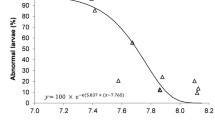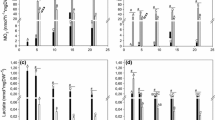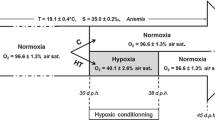Abstract
Early life stages of marine crustaceans respond sensitively to elevated seawater PCO2. However, the underlying physiological mechanisms have not been studied well. We therefore investigated the effects of elevated seawater PCO2 on oxygen consumption, dry weight, elemental composition, median developmental time (MDT) and mortality in zoea I larvae of the spider crab Hyas araneus (Svalbard 79°N/11°E; collection, May 2009; hatch, December 2009). At the time of moulting, oxygen consumption rate had reached a steady state level under control conditions. In contrast, elevated seawater PCO2 caused the metabolic rate to rise continuously leading to a maximum 1.5-fold increase beyond control level a few days before moulting into the second stage (zoea II), followed by a pronounced decrease. Dry weight of larvae reared under high CO2 conditions was lower than in control larvae at the beginning of the moult cycle, yet this difference had disappeared at the time of moulting. MDT of zoea I varied between 45 ± 1 days under control conditions and 42 ± 2 days under the highest seawater CO2 concentration. The present study indicates that larval development under elevated seawater PCO2 levels results in higher metabolic costs during premoulting events in zoea I. However, H. araneus zoea I larvae seem to be able to compensate for higher metabolic costs as larval MDT and survival was not affected by elevated PCO2 levels.





Similar content being viewed by others
References
Anger K (1983) Moult cycle and morphogenesis in Hyas araneus larvae (Decapoda, Majidae), reared in laboratory. Helgol Meeresunters 36:285–302
Anger K (2001) The biology of decapod crustacean larvae. Crustacean Issue 14. A.A. Balkema Publishers, Swets and Zeitlinger, Lisse
Anger K (2003) Salinity as a key parameter in the larval biology of decapod crustaceans. Invertebr Reprod Dev 43(1):29–45
Anger K, Dawirs RR (1981) Influence of starvation on the larval development of Hyas araneus (Decapoda, Majidae). Helgol Meeresunters 34:287–311
Anger K, Dawirs RR (1982) Elemental composition (C, N, H) and energy in growing and starving larvae of Hyas araneus (Decapoda, Majidae). Fish Bull NOAA 80:419–433
Anger K, Jacobi CC (1985) Respiration and growth of Hyas araneus L. larvae (Decapoda: Majidae) from hatching to metamorphosis. J Exp Mar Biol Ecol 88:257–270
Anger K, Harms J, Püschel C, Seeger B (1989) Physiological and biochemical changes during larval development of a brachyuran crab reared under constant conditions in the laboratory. Helgol Meeresunters 43:225–244
Anger K, Spivak E, Luppi T (1998) Effects of reduced salinities on development and bioenergetics of early larval shore crab, Carcinus maenas. J Exp Mar Biol Ecol 220:287–304
Anger K, Thatje S, Lovrich G, Calcagno J (2003) Larval and early juvenile development of Paralomis granulosa reared at different temperatures: tolerance of cold and food limitation in a lithodid crab from high latitudes. Mar Ecol Prog Ser 253:243–251
Arnold KE, Findlay HS, Spicer JI, Daniels CL, Boothroyd D (2009) Effect of CO2-related acidification on aspects of the larval development of the European lobster, Homarus gammarus (L.). Biogeosciences 6:1747–1754
Bechmann RK, Taban IC, Westerlund S, Godal BF, Arnberg M, Vingen S, Ingvarsdottir A, Baussant T (2011) Effects of Ocean acidification on early life stages of shrimp (Pandalus borealis) and mussel (Mytilus edulis). J Toxicol Environ Health Part A 74:424–438
Cameron JN (1978) Effects of hypercapnia on blood acid-base status, NaCl fluxes, and trans-gill potential in freshwater blue crabs, Callinectes sapidus. J Comp Physiol 123:137–141
Christiansen ME (1969) Crustacea Decapoda Brachyura. Marine invertebrates of Scandinavia, vol 2. Universitetsforlaget, Oslo
Dawirs RR (1983) Respiration, energy balance and development during growth and starvation of Carcinus maenas L. larvae (Decapoda: Portunidae). J Exp Mar Biol Ecol 69:105–128
Dissanayake A, Clough R, Spicer JI, Jones MB (2010) Effects of hypercapnia on acid–base balance and osmo/ionoregulation in prawns (Decapod: Palaemonidae). Aquat Biol 11:27–36
Drach P (1939) Mue et cycle d’intermue chez les Crustacés decapodés. Annls Institut Océanographique, Monaco 19:103–391
Dupont S, Dorey N, Stumpp M, Melzner F, Thorndyke M (2012) Long-term and trans-life-cycle effects of exposure to ocean acidification in the green sea urchin Strongylocentrotus droebachiensis. Mar Biol. doi:10.1007/s00227-012-1921-x
Findlay HS, Kendall MA, Spicer JI, Widdicombe S (2010) Relative influence of ocean acidification and temperature on intertidal post-larvae at the northern edge of their geographic distribution. Estuar Coast Shelf Sci 86:675–682
Hop H, Pearson T, Hegseth EN, Kovacs KM et al (2002) The marine ecosystem of Kongsfjorden, Svalbard. Polar Res 21:167–208
Jacobi CC, Anger K (1985) Effect of temperature on respiration of larval stages of Hyas araneus and H. coarctatus (Decapoda, Majidae). Mar Ecol Prog Ser 26:181–186
Kurihara H, Ishimatsu A (2008) Effects of high CO2 seawater on the copepod (Acartia tsuensis) through all life stages and subsequent generations. Mar Pollut Bull 56(6):1086–1090
Kurihara H, Shimode S, Shirayama Y (2004) Effects of raised CO2 concentration on the egg production rate and early development of two marine copepods (Acartia steueri and Acartia erythraea). Mar Pollut Bull 49:721–727
Landry MR (1983) The development of marine calanoid copepods with comment on the isochronal rule. Limnol Oceanogr 28:614–624
Langenbuch M, Pörtner HO (2003) Energy budget of hepatocytes from Antarctic fish (Pachycara brachycephalum and Lepidonotothen kempi) as a function of ambient CO2: pH-dependent limitations of cellular protein biosynthese? J Exp Biol 206:3895–3903
Langenbuch M, Bock C, Leibfritz D, Pörtner HO (2006) Effects of environmental hypercapnia on animal physiology: a (31) P-NMR study of protein synthesis rates in the marine invertebrate Sipunculus nudus. Comp Biochem Physiol A 144:479–484
Lannig G, Eilers S, Pörtner HO, Sokolova IM, Bock C (2010) Impact of Ocean acidification on energy metabolism of Oyster, Crassostrea gigas—Changes in metabolic pathways and thermal response. Mar Drugs 8:2318–2339
Lewis E, Wallace DWR (1998) Program developed for CO2 system calculations. ORNL/CDIAC-105. Carbon Dioxide Information Analysis Center, Oak Ridge National Laboratory, Oak Ridge, TN
Lischka S, Büdenbender J, Boxhammer T, Riebesell U (2010) Impact of ocean acidification and elevated temperatures on early juveniles of the polar shelled pteropod Limacina helicina: mortality, shell degradation, and shell growth. Biogeosci Discuss 7:8177–8214
Luquet CM, Ansaldo M (1997) Acid-base balance and ion regulation during emersion in estuarine intertidal crab Chasmagnathus granulata Dana (Decapoda Grapsidea). Comp Biochem Phys A 3:407–410
Martin S, Richier S, Pedrotti ML, Dupont S, Castejon C, Gerakis Y, Kerros ME, Oberhänsli F, Teyssié JL, Jeffree R, Gattuso JP (2011) Early development and molecular plasticity in the Mediterranean sea urchin Paracentrotus lividus exposed to CO2-driven acidification. J Exp Biol 214:1357–1368
Melzner F, Gutowska MA, Langenbuch M, Dupont S, Lucassen M, Thorndyke MC, Bleich M, Pörtner HO (2009) Physiological basis for high CO2 tolerance in marine ectothermic animals: pre-adaptation through lifestyle and ontogeny? Biogeosciences 6:2313–2331
Michaelidis B, Ouzounis C, Paleras A, Pörtner HO (2005) Effects of long-term moderate hypercapnia on acid–base balance and growth rate in marine mussels Mytilus galloprovincialis. Mar Ecol Prog Ser 293:109–118
Noack S (1980) Statistische Auswertung von Mess- und Versuchsdaten mit Taschenrechner und Tischcomputer. Walter de Gruyter, Berlin
Pane EF, Barry JP (2007) Extracellular acid-base regulation during short-term hypercapnia is effective in a shallow-water crab, but ineffective in a deep-sea crab. Mar Ecol Prog Ser 334:1–9
Petersen S (1995) The embryonic development of Hyas araneus L. (Decapoda, Majidae): effects of temperature. Sarsia 80:193–198
Pörtner HO, Hardewig I, Sartoris FJ, van Dijk PLM (1998) Energetic aspects of cold adaptation: critical temperatures in metabolic, ionic and acid–base regulation? In: Pörtner HO, Playle R (eds) Cold ocean physiology. Cambridge University Press, Cambridge, pp 88–120
Pörtner HO, Bock C, Reipschläger A (2000) Modulation of the cost of pHi regulation during metabolic depression: a 31P-NMR study in invertebrate (Sipunculus nudus) isolated muscle. J Exp Biol 203:2417–2428
Pörtner HO, Dupont S, Melzner F, Storch D, Thorndyke M (2010) Studies of metabolic rate and other characters across life stages. In: Riebesell U, Fabry V, Gattuso JP (eds) Guide to best practices for ocean acidification research and data reporting. Publications Office of the European Union, Luxembourg, pp 167–180
Reipschläger A, Pörtner HO (1996) Metabolic depression during environmental stress: the role of extracellular versus intracellular pH in Sipunculus nudus. J Exp Biol 199:1801–1807
Spicer JI, Eriksson SP (2003) Does the development of respiratory regulation always accompany the transition from pelagic larvae to benthic fossorial postlarvae in the Norway lobster Nephrops norvegicus (L.)? J Exp Mar Biol Ecol 295:219–243
Spicer JI, Raffo A, Widdicombe S (2007) Influence of CO2-related seawater acidification on extracellular acid–base balance in the velvet swimming crab Necora puber. Mar Biol 151:1117–1125
Steinacher M, Joos F, Frölicher TL, Plattner G-K, Doney SC (2009) Imminent ocean acidification in the Arctic projected with the NCAR global coupled carbon cycle-climate model. Biogeosciences 6:515–533
Storch D, Santelices P, Barria J, Cabeza K, Pörtner HO, Fernández M (2009) Thermal tolerance of crustacean larvae (zoea I) in two different populations of the kelp crab Taliepus dentatus (Milne-Edwards). J Exp Biol 212:1371–1376
Stumpp M, Wren J, Melzner F, Thorndyke MC, Dupont S (2011) CO2 induced seawater acidification impacts sea urchin larval development I: elevated metabolic rates decrease scope for growth and induce developmental delay. Comp Biochem Phys A 160(3):331–340
Thomsen J, Melzner F (2010) Moderate seawater acidification does not elicit long-term metabolic depression in the blue mussel Mytilus edulis. Mar Biol 157:2667–2676
Varley DG, Greenaway P (1992) The effect of emersion on haemolymph acid-base balance and oxygen levels in Scylla serrata Forskal (Brachyura: Portunidae). J Exp Mar Biol Ecol 163(1):1–12
Walther K, Anger K, Pörtner HO (2010) Effects of ocean acidification and warming on the larval development of the spider crab Hyas araneus from different latitudes (54° vs. 79°N). Mar Ecol Prog Ser 417:159–170
Walther K, Sartoris FJ, Pörtner HO (2011) Impacts of temperature and acidification on larval calcium incorporation of the spider crab Hyas araneus from different latitudes (54° vs. 79°N). Mar Biol 158:2043–2053. doi:10.1007/s00227-011-1711-x
Wheatly M, Henry RP (1992) Extracellular and intracellular acid-base regulation in crustaceans. J Exp Zool 263(2):127–142
Acknowledgments
Financial support was provided by Federal Ministry of Education and Research (BMBF), within phase I of the BIOACID research programme (FKZ 03F0608B, subproject 2.2.1). We thank the scientific divers of the Alfred Wegener Institute for animal collection and C. Lorenzen for technical assistance.
Author information
Authors and Affiliations
Corresponding author
Additional information
Communicated by S. Dupont.
Rights and permissions
About this article
Cite this article
Schiffer, M., Harms, L., Pörtner, H.O. et al. Tolerance of Hyas araneus zoea I larvae to elevated seawater PCO2 despite elevated metabolic costs. Mar Biol 160, 1943–1953 (2013). https://doi.org/10.1007/s00227-012-2036-0
Received:
Accepted:
Published:
Issue Date:
DOI: https://doi.org/10.1007/s00227-012-2036-0




